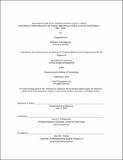Adjusted pure-play portfolio REIT equity index : historical performance of public and privacy real estate investment
Author(s)
Kim, Dongwook, S.M. Massachusetts Institute of Technology
DownloadFull printable version (339.4Kb)
Alternative title
Adjusted pure-play portfolio Real Estate Investment Trust equity index : historical performance of public and privacy real estate investment
Other Contributors
Massachusetts Institute of Technology. Dept. of Architecture.
Advisor
Henry O. Pollakowski.
Terms of use
Metadata
Show full item recordAbstract
The public real estate market was initiated by the Real Estate Investment Trust Act of 1960. Since then, investors have been concerned with the assessment of performance comparisons between publicly held assets and privately held assets. The main concern for the assessment is to reveal historically which type of ownership provided the more efficient vehicle for the investors. The National Council of Real Estate Investment Fiduciaries (NCREIF) provides the investment performance of privately held commercial real estate, and the National Association of Real Estate Investment Trust (NAREIT) provides that of publicly held commercial real estate by REITs. However, direct comparison between the two indexes is problematic due to the different characteristics of each market and the lack of historical data for accurate assessment. The primary purpose of this study is to adjust characteristics of commercial REIT assets underlying one portfolio to match the characteristics of privately held commercial assets. Since SNL data base provides hedonic data from 1995 and CRSP & Compustat merged data base provides up to 2005 Q4, the sample period of this research is from 1995 Q1 to 2005 Q4. This quarterly assessment is conducted at the property sector (retail, apartment, office and industrial), then at the aggregate level. The main research of this thesis is to create adjusted REIT equity index that is derived from the following treatments in the thesis. Pure-Play' Portfolio Methodology will be applied to replicate the performance of four real estate property-type sectors defined by NCREIF - Implemented updated Equity to Total Asset ratio from De-leveraging REIT returns by WACC formula based on CRSP and Compustat merged data to obtain the value weights of equity, debt and total assets. (cont.) As a proxy for the returns of debts held by REITs, Gilberto-Levy Historical Mortgage Rate will be used as a proxy for the returns of debts held by REITs. Sector-Mix Adjustment according to NCREIF sector weights. REIT index investment cost proxied by Vanguard REIT fund expense (95-05) will be deducted from adjusted REIT equity index. In this thesis, private real estate equity investment performance is represented by the MIT Transaction Based Index (TBI) and NCREIF Property Index (NPI). Both TBI and NPI returns are deducted by asset management fees estimated by the NFI-ODCE index (NCREIF) over the same time period. Purpose of these adjustments is to improve evaluation of publicly and privately held commercial real estate asset investment performances relative to one another. Preliminary comparison between NAREIT equity REIT index and NPI quarterly returns from 1995-2005 was conducted to collect the mean return difference. Then the difference after the treatments was compared to observe the effects of the author's method. The results demonstrate that at the aggregate level the difference between REIT and NPI returns reduced from 1.08% to 0.74%, and the difference between REIT and TBI returns reduced from 1.64% to 0.18%.
Description
Thesis (S.M. in Real Estate Development)--Massachusetts Institute of Technology, Dept. of Architecture, 2007. This electronic version was submitted by the student author. The certified thesis is available in the Institute Archives and Special Collections. Includes bibliographical references (leaf 42).
Date issued
2007Department
Massachusetts Institute of Technology. Department of ArchitecturePublisher
Massachusetts Institute of Technology
Keywords
Architecture.